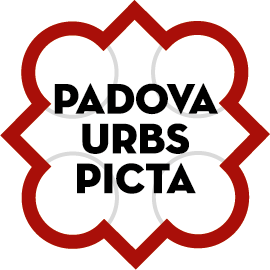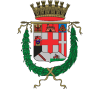Prato della Valle
A well-known puzzle about Padua speaks of it as the city of “a saint without a name, a meadow [prato] without grass, and a café without doors”. The saint is St. Anthony – known simply as Il Santo – the grassless ‘meadow’ is Prato della Valle, and the café is Pedrocchi’s, which ‘had no doors’ because it was open day and night. Prato della Valle, which is the starting-point for this itinerary (map: 1) is remarkable both for its size (after Red Square in Moscow, it is the largest public square in Europe) and its layout: a central island surrounded by a canal crossed by four bridges and lined on either bank by statues of illustrious inhabitants of the city.
In the background, on the far side of the square, is the Basilica of St. Giustina (map: 2), which is dedicated to a Christian martyr who is one of the city’s four patron saints.
From the Botanical Garden to the Piazza del Santo
Passing along the south side of Prato della Valle, you come to the turning into Via Belludi, which leads up to the Basilica of St. Anthony (which on this itinerary you visit later). Going a little way up the street, you come to a turning on the right (map: 5), which leads to the oldest ‘Garden of Simples’ in Europe. After your visit to the Botanical Garden, continue up a street that is named after it (Via Orto Botanico), along a canal that was once used to deliver supplies to the Franciscan monks of St, Anthony’s and the Benedictine monks of St. Giustina’s. Having come back into Via Belludi, turn right and you are in Piazza del Santo (map: 3). For almost 800 years the Basilica of St. Anthony (map: 3) has been a place of pilgrimage; it has also attracted numerous artists, who have adorned it with their work. One of the greatest to work here was Donatello, and his famous equestrian monument to Erasmo da Narni (known as Il Gattamelata) stands in the open space in front of the Basilica; it is one of the symbols of the city. To the right of the Basilica, as you are looking at it, are the Oratory of St. George, the small Scoletta del Santo (map: 4) and the Museo al Santo; within its cloisters is the Museo Antoniano.
After your visit to these places, you can stroll though one of the most interesting old quarters of the city to Palazzo Zabarella; alternatively, you can get to the palazzo by taking the “Diretto Piazze” bus, which stops outside the Basilica of St. Anthony.
From Via Cesarotti to Via San Francesco
If you take the street to the left side of the basilica, as you are looking at it, you enter Via Cesarotti. At number 7 in this street is a building that is now used by the armed forces but which up to 1890 was home to the Collegio Pratense, founded in 1394 by Cardinal Pileo da Prato for impoverished students. Various sources say that the great architect Andrea Palladio – probably after his numerous absences from work had led to him being struck off the payroll by Vicenza City Council – enrolled his younger son here so that he could continue with his studies at the University.
At 37 Via Cesarotti stands the Cornaro Loggia and Odeo (map : 6). Commissioned as a dedicated theatre and music venue by Alvise Cornaro, a wealthy patron of the arts, this was where Ruzzante, a local dialect playwright, put on his irreverent comedies; it was also a place for the performance of music and the recitation of poetry.
Contrada Antenore
At the end of Via Cesarotti you come to Via San Francesco; turning right you would continue towards Porta Pontecorvo (map: 7), while turning left you walk back up to the city centre (the Canton del Gallo and the pedestrian area). Once known as the Contrada Antenore [Antenore Neighbourhood], this whole district is home to numerous artistic and historical treasures, many of which have just recently been restored or are currently undergoing restoration.
Walking up past Via Galilei and the complex formed by the church and hospital of San Francesco (map: 8), you come to the crossroads with Via del Santo, opposite which stands Palazzo Zabarella (map: 9), now a venue for internationally-prestigious exhibitions.
A little further on and Via San Francesco comes to an end in Piazza Antenore (map: 10). Here you can find the aedicula that houses what was once claimed to be the tomb of Antenor, a hero of the Enetoi of Paphlagonia, whose men fought with Troy against the Greeks but managed to escape the fate of so many when that city was put to the torch.
If you are tired, you can, at the end of Piazza Antenore, turn into Riviera Tito Livio, where you can catch a bus or tram back to Prato della Valle.
Walking back to Prato della Valle
If you walk up to Canton del Gallo [Cockerel Corner] – so named because once the site of an inn “at the sign of the Cockerel” – you turn left into Via Roma. This pedestrian street is lined with fashionable shops and also has numerous cafés and bars. Some way along the street you come to Ponte delle Torricelle [Bridge of the Small Towers], so called because probably there were two towers alongside the thirteenth-century city gateway here. The bridge was built in the sixteenth century on the foundations of a Roman bridge, and spans the Inner Shipping Canal (Naviglio Interno). This is one of the few remaining stretches of this waterway; most it has been filled in, but it once ran along what is now the route of Riviera Ponti Romani (the only trace of the waterway here open to the public is the Ponte San Lorenzo; map: 11) and the Riviera Tito Livio. On the other side of the bridge begins Via Umberto I, again lined with shops and cafes. This takes you past the church of Santa Maria dei Servi (map: 50) to your starting-point: Prato della Valle. On the corner of the street and square stands the Museum of Pre-Cinema, which houses the Minici Zotti collection (map: 46); a truly special museum, this contains a range of magic lanterns and examples of the other appartus that was used to project moving figures and images in the centuries before the Lumière brothers came up with their invention. With this dive into a past that so clearly heralded the future, this particular itinerary through the streets of Padua comes to an end.












